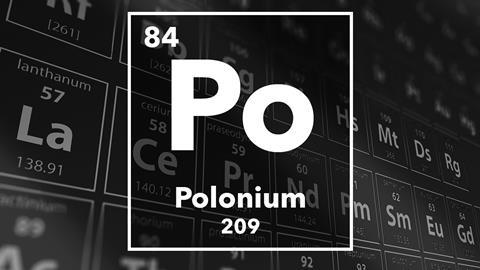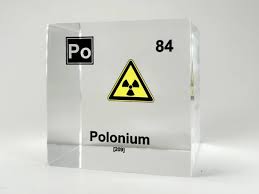Identity.
Polonium, with the symbol Po and atomic number 84, is a rare and
highly radioactive element. Classified as a chalcogen, it shares some
chemical similarities with selenium and tellurium, but its metallic
character aligns it more closely with elements like lead and bismuth.
All its isotopes are unstable, with the naturally occurring
polonium-210 found in trace amounts within uranium ores having a short
half-life of 138 days. Despite its radioactivity, polonium finds
limited applications in specific scientific and industrial settings,
though its extreme toxicity necessitates strict handling procedures
and specialized facilities.
History.
In 1898, while researching the radioactivity of pitchblende, Marie and
Pierre Curie stumbled upon a new element exhibiting exceptional
radioactive properties. Recognizing it as distinct from the known
element uranium, they named it "polonium" after Marie's native Poland,
then under foreign rule. This audacious act served as a symbolic
gesture of national pride and defiance.
Extracting polonium from tons of pitchblende was a laborious task,
highlighting its rarity. Initially used in anti-static devices due
to its alpha particle emission, polonium later found applications
in space exploration as heat sources in probes and research
instruments requiring compact and efficient radioactive sources.
Polonium's potent radioactivity, while valuable in specific
applications, also poses a significant threat. Its extreme
toxicity has unfortunately been exploited in poisoning incidents,
highlighting the critical need for strict regulations and
responsible handling of this element.
Usage.
Despite its radioactivity, polonium finds limited yet specific
applications. Its ability to emit alpha particles makes it valuable in
static eliminators, removing unwanted static charges in industrial
processes like paper manufacturing. Polonium also serves as a compact
heat source in space probes and research instruments due to its
efficient heat generation, though its short half-life limits its
long-term use. However, its extreme toxicity necessitates cautious
handling and restricted use, with alternative solutions often
preferred for safety and practicality.
-
Static Eliminators: Polonium's alpha particle emission
effectively neutralizes static charges, making it useful in
various industrial settings like paper and textile manufacturing
to prevent sparks and improve product quality.
-
Heat source in Space Exploration: Due to its compact size
and efficient heat generation, polonium-210 has been used in
radioisotope thermoelectric generators (RTGs) to power spacecraft
and scientific instruments in remote locations where solar energy
is unavailable.
-
Neutron Sources: When bombarded with alpha particles,
polonium can produce neutrons, making it a valuable tool for
scientific research in fields like nuclear physics and material
analysis.
-
Lonization Sources: Polonium's radioactivity can ionize air
molecules, creating a conductive path for electrical current. This
property finds limited application in specific ionization devices
for smoke detectors or gas leak detection.
Some of the benefits of using Polonium are:
-
Polonium-210 generates a significant amount of heat for its size,
making it a compact and efficient power source for applications
like radioisotope thermoelectric generators (RTGs) in space
exploration.
-
Polonium's alpha particle emission effectively neutralizes static
charges, preventing sparks and improving product quality in
various industrial processes like paper and textile manufacturing.
-
When bombarded with alpha particles, polonium can produce
neutrons, making it a valuable tool for specific scientific
research in fields like nuclear physics and material analysis.
-
Polonium's radioactivity can ionize air molecules, creating a
conductive path for electrical current. This property finds
limited application in specific ionization devices for smoke
detectors or gas leak detection.
Sources.
Polonium exists in minute quantities in nature, primarily found as
traces within uranium ores. However, extracting it from this source is
impractical due to its extreme rarity. The primary method for
obtaining polonium today involves bombarding bismuth-209 with neutrons
in nuclear reactors. This process triggers a decay chain, ultimately
resulting in the production of polonium-210, the most common isotope.
Due to its short half-life, polonium requires continuous production to
meet even limited industrial and research needs.


